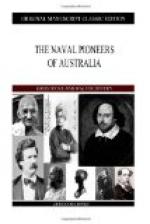Coming back to the first naval expedition to Australia, the ship commanded by Dampier was the Roebuck, as Evelyn tells us, a vessel of 290 tons. Dampier has left very little description of his ship, but it is not difficult to picture her, for by this time the ratings of ships had been settled upon certain lines, and the meaning of the word “rating” as used at this period is easily ascertainable.
According to Charnock’s Marine Architecture, the Roebuck, lying at Deptford in June, 1684, was a sixth-rate of 24 guns and 85 men. This was her war complement; but Dampier himself tells us that he “sailed from the Downs early on Saturday, January 14th, 1699, with a fair wind, in His Majesty’s ship the Roebuck, carrying but 12 guns on this voyage and 50 men with 20 months’ provisions.”
In 1677, according to James’ History, the smallest fifth-rate then afloat corresponds nearest to the Roebuck, and, no doubt, by Dampier’s time this vessel had been reduced in her rating. The vessel of 1677 is described as being of 265 tons and 28 guns, “sakers and minions,” with a complement of about 100 men. The largest sixth-rate was 199 tons, 18 guns, and 85 men. So from these particulars we can take it as correct that the Roebuck in 1699 was a sixth-rate. It is worth remembering that in Cavendish’s second expedition to the South Sea, in 1591, there was a ship called the Roebuck, commanded by John Davis, and likely enough the sixth-rate in which Dampier sailed was named after her, those who gave her the name little thinking at the time of her christening (she was built before Dampier’s voyage, and was certainly not the Roebuck of Cavendish’s fleet) how appropriately they were naming her for her future service.
[Illustration: THE SOVEREIGN OF THE SEAS, BUILT IN THE YEAR 1637. From a print in the British Museum by Paine.]
Her armament is a matter of interest, for just about her time—that is, between the years 1685 and 1716—the naming of guns after beasts and birds of prey went out of fashion, and they were distinguished by the weight of the shot fired. James, quoting from Sir William Monson’s Naval Tracts, supplies the following table on the subject of sea guns; and, as they were probably still in use in Dampier’s time, we print it here:—
| Bore of | Weight of | Weight of | Weight of Names. |cannon in | cannon in | shot in | powder in | inches. | pounds. | pounds. | pounds. | | | | Cannon-royal | 8-1/2 | 8000 | 66 | 30 Cannon | 8 | 6000 | 60 | 27 Cannon-serpentine | 7 | 5500 | 53-1/2 | 25 Bastard cannon | 7 | 4500 | 41 | 20 Demi-cannon | 6-3/4 | 4000 | 33-1/2 | 18 Cannon-petro | 6 | 4000 | 24-1/2 | 14 Culverin | 5-1/2 | 4500 | 17-1/2 | 12




